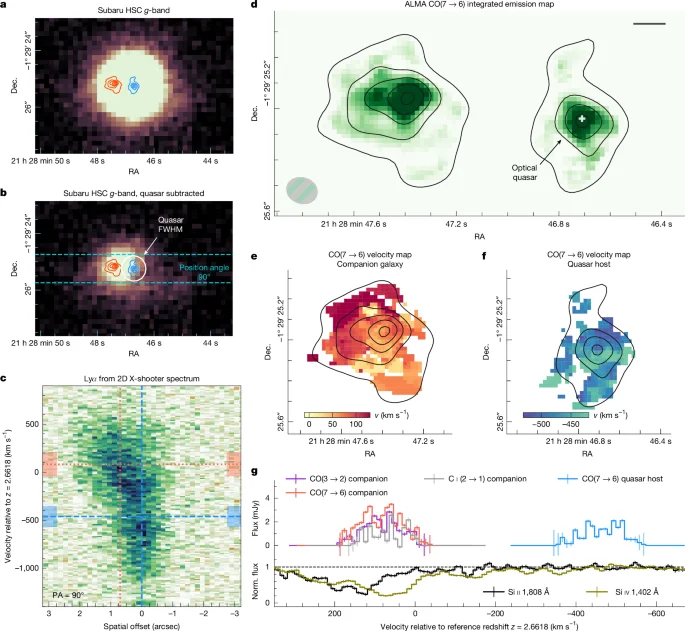
Cosmic Joust: Galaxy Sabotages Rival with Quasar Beam in Epic Deep-Space Battle
In a stunning astronomical observation, scientists have witnessed a galactic clash of cosmic proportions. Two galaxies, hurtling toward each other at breakneck speeds, are locked in a battle for the ages. However, it's not a fair fight. One galaxy is using the intense radiation of a quasar to disrupt the star formation of its rival, effectively sabotaging its evolution. Scientists dub this interaction a "cosmic joust," a medieval-style battle played out on a galactic scale.

Using the Atacama Large Millimeter/submillimeter Array (ALMA) in Chile and the European Southern Observatory's Very Large Telescope, a team of astronomers captured this extraordinary event. This "cosmic joust" provides unprecedented insight into the violent interactions that shaped the early universe. The observations revealed a galaxy armed with a quasar, essentially a supermassive black hole actively consuming matter and emitting intense radiation, firing a beam directly into its neighboring galaxy.
"We discovered a quasar—likely triggered by the merging of two galaxies—that is actively transforming the gas structure in its companion galaxy," explained Pasquier Noterdaeme, a CNRS researcher at the Institut d’Astrophysique de Paris. This discovery offers direct evidence supporting the long-held theory that galaxy mergers give rise to quasars.

The radiation spear, powered by the quasar, slices through clouds of gas and dust within the other galaxy, the raw material for new stars. This disruption severely limits the ability of the targeted galaxy to form new stars. As Sergei Balashev, a researcher at the Ioffe Institute in Russia, stated, "We see for the first time the effect of a quasar's radiation directly on the internal structure of the gas in an otherwise regular galaxy."
This galactic duel provides invaluable insights into how quasars influence the evolution of galaxies. The merging galaxies funnel gas toward the central black hole of the quasar-wielding galaxy, fueling its violent outbursts and turning it into a destructive weapon. The light from this clash has traveled 11 billion years to reach us so it is observed as it was when the universe was just 18% of its current age. The observations indicate that radiation released by the quasar disrupts the clouds of gas and dust in the regular galaxy, leaving only the smallest, densest regions behind. These regions are likely too small to be capable of star formation.
Future telescopes, such as the Extremely Large Telescope (ELT), promise to reveal even more details about these ancient galactic brawls. These advanced instruments will enable scientists to dissect the interactions between quasars and galaxies, giving us a clearer picture of the universe's formative years and the forces that shaped the galaxies we see today.
This groundbreaking observation raises fascinating questions about the role of quasars in galactic evolution. Are these cosmic jousts common occurrences? How significantly do they hinder star formation in victim galaxies? Share your thoughts and theories in the comments below!